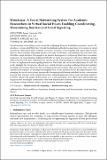Who2chat: A Social Networking System for Academic Researchers in Virtual Social Hours Enabling Coordinating, Overcoming Barriers and Social Signaling
Author(s)
Park, Soya; Song, Jaeyoon; Karger, David R.; Malone, Thomas W.
Download3637435.pdf (2.578Mb)
Publisher Policy
Publisher Policy
Article is made available in accordance with the publisher's policy and may be subject to US copyright law. Please refer to the publisher's site for terms of use.
Terms of use
Metadata
Show full item recordAbstract
Virtual academic networking is socio-technically challenging, however, fruitful for researchers' success. We introduce a system called Who2chat to tackle the challenge and facilitate connections of researchers in virtual social hours. Who2chat allows academic researchers to create a research profile and express their research interests, find researchers with similar interests, overcome social barriers, and coordinate and start video chats, all within a single interface. We engaged in an iterative design process by deploying Who2chat at academic conferences. In our preliminary deployment (N=80), we found that researchers often have difficulty finding other researchers who share similar interests, and they are shy about reaching out to other researchers. Inspired by this, we implemented social-signaling features to Who2chat and ran our first deployment (N=220). Our results highlight that the interface allowed users to find relevant researchers and helped them feel confident in joining conversations. However, this led to large group conversations where discussion topics were more superficial. In response, we developed and deployed our second interface (N=81). Key improvements were managing the size of conversations, dynamically determining and allowing individuals to join a conversation based on their relevance to the ongoing discussion, and maintaining the ratio of senior and junior members, to further enhance the quality of discussions. As a result, participants were able to meet more people and engage in more meaningful conversations. Our work demonstrates an interface design for social networking in academic settings and how to lower social barriers in virtual networking.
Date issued
2024-04-17Department
Sloan School of Management; Massachusetts Institute of Technology. Department of Electrical Engineering and Computer Science; Massachusetts Institute of Technology. Computer Science and Artificial Intelligence LaboratoryJournal
Proceedings of the ACM on Human-Computer Interaction
Publisher
Association for Computing Machinery
Citation
Park, Soya, Song, Jaeyoon, Karger, David R. and Malone, Thomas W. 2024. "Who2chat: A Social Networking System for Academic Researchers in Virtual Social Hours Enabling Coordinating, Overcoming Barriers and Social Signaling." Proceedings of the ACM on Human-Computer Interaction, 8 (CSCW1).
Version: Final published version
ISSN
2573-0142